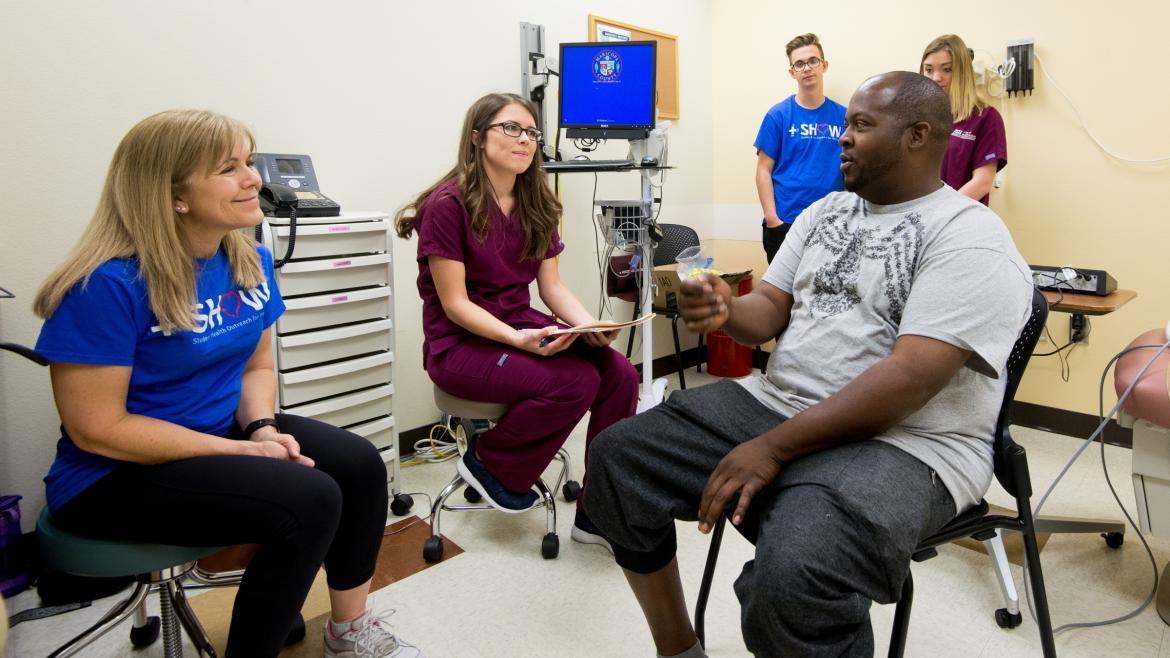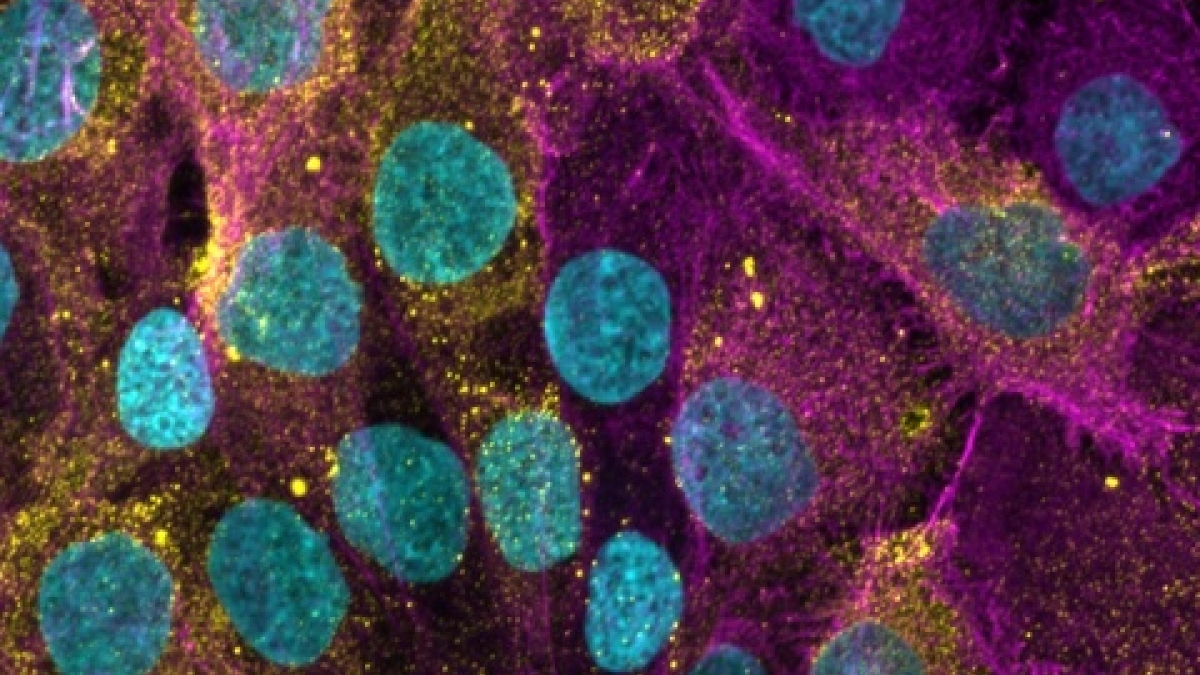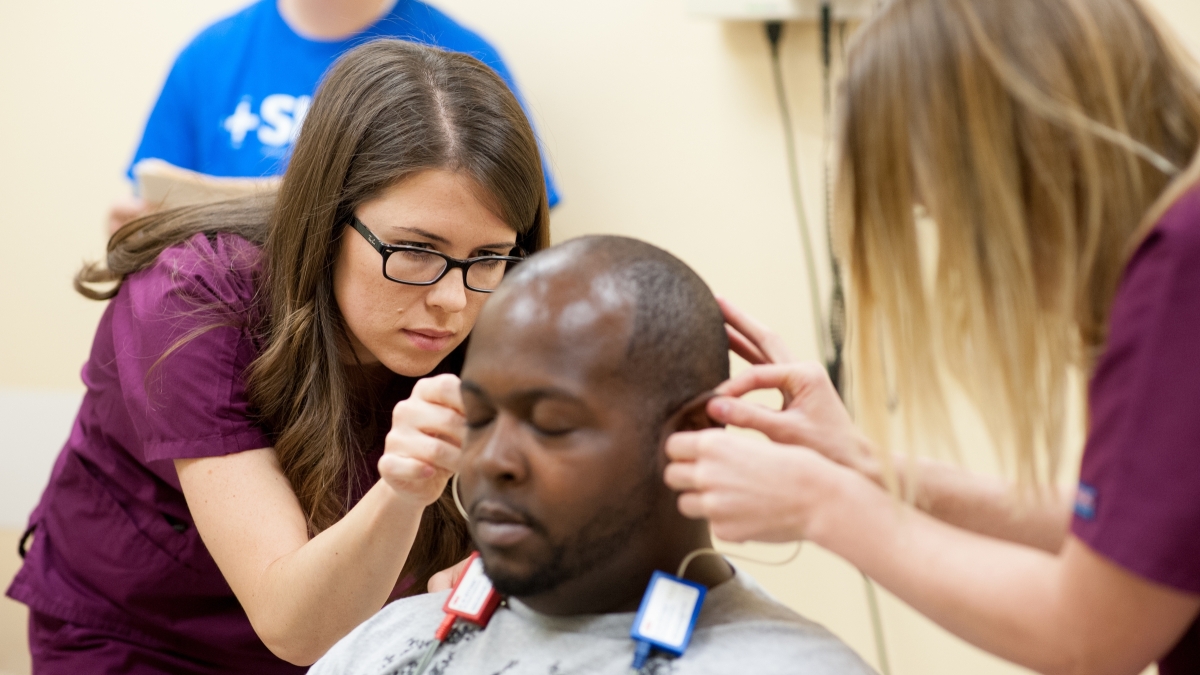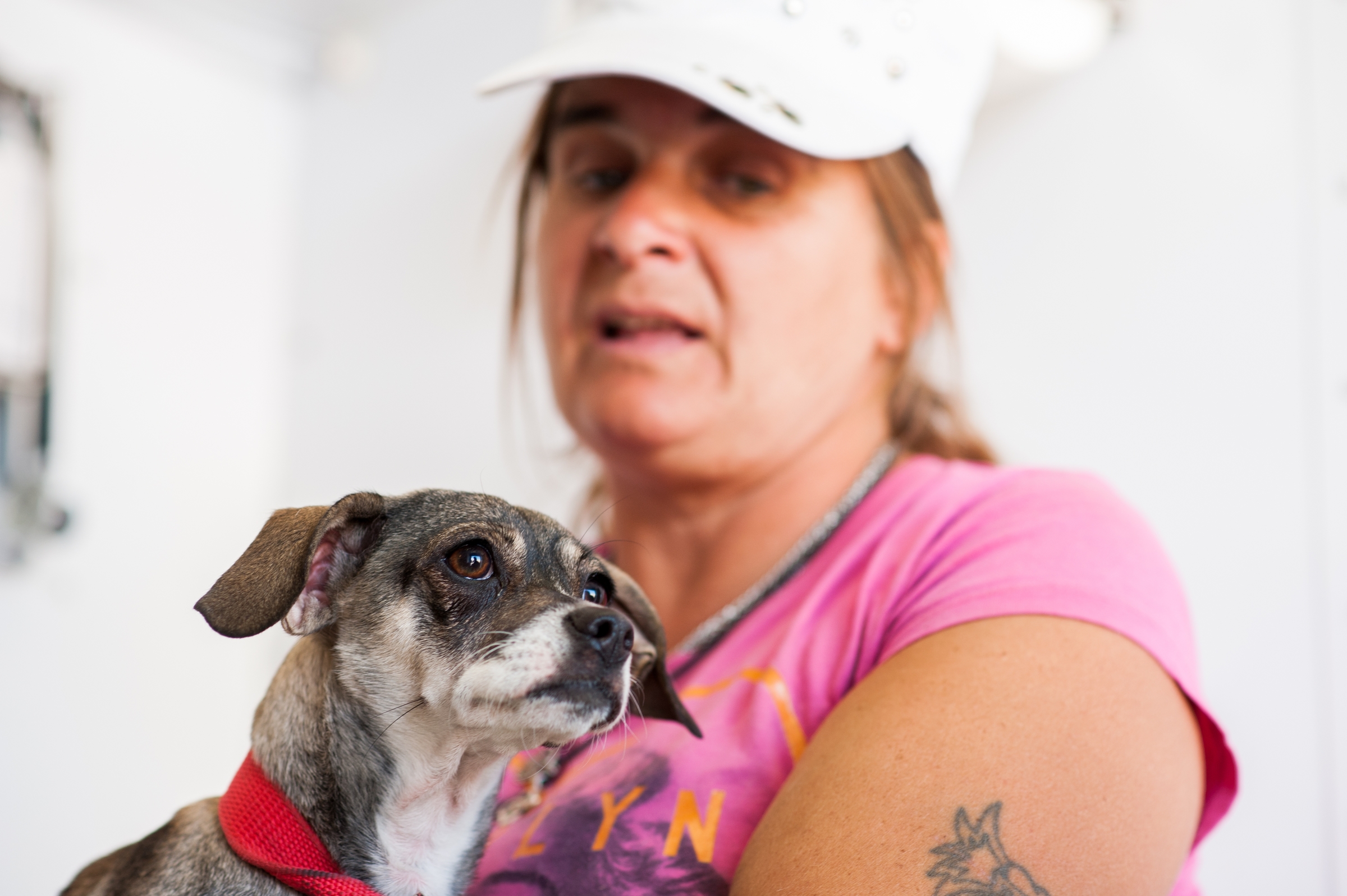Monique Greco and Garnett Johnson might go hungry sometimes, but they make sure their dog Codi never does.
The homeless couple was visiting the Student Health Outreach for Wellness clinic (SHOW) in the heart of downtown Phoenix, which for the month of April also features pet-health services thanks to an ASU student’s initiative.
“Codi is everything to us,” said Greco about her 8-month-old pit bull, who was getting an exam, micro-chipped and a full set of vaccinations April 2.
“He’s our kid and we always put him first. If we’re hungry, the dog eats first.”
That sort of attitude goes a long way with Amber Howarth, who spearheads Wandering Paws, a mobile veterinarian clinic that has partnered with the Arizona Humane Society and services animals for the homeless and underserved.
Howarth, a 22-year-old ASU senior majoring in biological scienceHowarth is a student in the College of Liberal Arts and Sciences., has a soft spot for animals. She’s developing a similar attitude towards the homeless population.
“I got involved with SHOW when my friend took me to one of their meetings and noting they serviced the homeless population. I thought, ‘Oh, I could add to this,’” said Howarth, who started the eight-week pilot program last month. “I’ve seen a lot of homeless people with pets and felt I could add a veterinary component to the clinic.”
Shirley Gibson listens to veterinary advice during a free clinic on April 2 in downtown Phoenix. For the month of April, the Student Health Outreach for Wellness clinic offers pet-health services in addition to the human care it provides year-round. Top photo: Volunteer Lauren Meadows (left) examines Corry Stewart for an audiology checkup that same day. Photos by Ben Moffat/ASU Now
The addition is welcome, and may help bring more notice to the human side of the clinic.
SHOW is a student-run, interdisciplinary team of volunteers from Arizona’s three state universities: Arizona State University, Northern Arizona University and the University of Arizona. Its mission is to provide holistic, client-centered health care for the homeless and underserved and operates in collaboration with the ASU Foundation. More than 150 students from 16 professional programs across the three universities worked together with faculty and community partners on the design, implementation and evaluation of the SHOW program.
The clinic, which has been open every Saturday since last August, has served more than 900 patients in its eight months of operation. Recent evaluations estimate that more than 27,000 Arizona residents experience homelessness each year.
SHOW operates out of Health Care for Homeless on the 12-acre Human Services Campus in downtown Phoenix to combat the weekend gap in health services while giving students real-world experience. Services are free to any individual meeting the medical or social-service criteria.
Students are supervised by licensed clinical faculty from the university and community providers, which includes ASU’s Dr. Liz HarrellHarrell is a clinical associate professor in the College of Nursing and Health Innovation., program director and psychiatric nurse.
“In 2001, The Institute of Medicine reviewed United States health care and reported that it needed to fundamentally change in order to provide quality health care,” Harrell said. “If you don’t have an employer that offers health care or you’re out of a job, you’re also out of luck. Those struggling with social disparities such as the homeless experience even poorer quality of care.”
Harrell said the World Health Organization (WHO) came up with three recommendations to improve health outcomes in this country: focus on the entire health-care population, improve cost and improve the patient experience. The WHO suggested interdisciplinary, or team-based care, was the best way to tackle all three.
“As educators we thought, ‘If this is the direction that health care is heading, then we need to teach that model,’” Harrell said. “The other question was, ‘How do you do that?’ SHOW really filled that practice place, and our patients are receiving a level of care they’ve never been privileged to have before and that’s incredibly meaningful.”
SHOW’s clinical health students range from nursing, social work, nutrition, medicine and pharmacy to audiology, speech pathology, physical therapy, business, journalism and computer science. They are responsible for the assessment, diagnosis, treatment and follow-up care delivery for patients, and have implemented many innovative ideas in their program, including an electronic whiteboard filled with a patient’s information, combination of professionals from different medical fields, and a greeting from a “patient navigator.”

ASU clinical professor of audiology Ingrid McBride (left) and volunteers Lauren Meadows, Colton Clayton and Ashley Geske consult with Corry Stewart during a checkup April 2.
“The navigator is the patient’s health advocate and stays with them through their entire visit,” said Sukhdeep Singh, SHOW student director and ASU senior in finance premedSingh is a student in the W. P. Carey School of Business and in Barrett, The Honors College.. “They are willing to get on a personal level with the patients. When I was a navigator, I bonded with patients by talking about my favorite food — Chinese. We don’t want this to be a demeaning environment because our goal is to treat them as human beings.”
That’s exactly how Taline Aydinian, a 21-year-old exercise and wellness junior, connects with her patients — on the human level.
“A lot of patients have told me they were abused when they were kids and other sad stuff that I imagine contributed to them being homeless and having health issues,” Aydinian said. “When they receive respect, they are more willing to open up to you because they don't get it that often. Everybody here in the clinic respects them and treats them as human beings.”
Twenty-two-year-old patient navigator Erika Alcantera, who is a public service and public policy majorAlcantera is a student in the College of Public Service and Community Solutions. at ASU, said she was initially weary about interacting with the homeless but has overcome that fear.
“I know now they’re just human beings and won’t bother you or do you any harm,” she said. “They’re very grateful for what we do, even the littlest things.”
“When other providers come here on the weekends to check us out, it just clicks for them. I heard one health professional say, ‘I’ve been practicing for 20 years, and I’ve never seen it done this way. And when I go back to the hospital, I’ll think about doing it this way.’”
— Sukhdeep Singh, SHOW student director and ASU senior
Patient Corry Stewart was grateful for the service he received recently. He came in for a routine wellness checkup, and the four-member team detected something out of the ordinary.
“They checked my blood pressure, sight, vision and hearing, and all was good until a doctor came and put a stethoscope up to my chest,” said Stewart, who is a pawn broker in Phoenix. “They told me that I have an irregular heartbeat. But other than that, I think I’m pretty healthy.”
The future of the clinic is also looking healthy, and many health-care organizations are looking at SHOW as a pioneer model, including the National Data Repository, which is collecting information from the clinic and dispensing it to interested clients.
“We get calls from people in other states curious about what we’re doing here and what is working. When other providers come here on the weekends to check us out, it just clicks for them,” said Singh. “I heard one health professional say, ‘I’ve been practicing for 20 years, and I’ve never seen it done this way. And when I go back to the hospital, I’ll think about doing it this way.’ It’s interesting to see them buy into this model.”
Harrell said SHOW is succeeding because the clinic is a “flattened hierarchy” where the students’ opinions matter just as much as the supervisors.
“Part of the problem in health care is that it’s traditionally been physician-focused, with that physician as the head of the team. No one person knows all,” Harrell said. “Part of interdisciplinary care is decision making is shared equally amongst the disciplines allowing for a more holistic care plan, thus improved quality care and greater provider satisfaction. We work very hard to make sure everybody is equal.”
And all things being equal, SHOW is emerging as a new health-care model around the country.
“Because SHOW isn’t constrained with the typical red tape associated with health care, we can try new ideas when it comes to patient care,” Harrell said. “We all know the recommendation is for us to do this, but who else can do this?
“The answer is ‘We can do this!’”
Wandering Paws will operate 9 a.m.-1 p.m. Saturdays through April. The human clinic, SHOW, runs 9 a.m. to noon Saturdays year-round. Both are at the Human Services Campus, 230 S 12th Ave., Phoenix.
More Health and medicine

80 years of pioneering speech and hearing services for the community
Over 80 years ago, in 1937, the first course in communication disorders, Speech Correction, was offered at Arizona State University. As additional courses were added and programs in speech…

First 2 degree offerings from ASU Health available in fall 2025
Editor’s note: This story is featured in the 2024 year in review.The first degree offerings from ASU Health will help students find jobs in the modernized health care system.The one-…

ASU study uses new biomaterials for wound healing
A minor cut often heals within days, vanishing without a trace. Yet, wound healing and tissue repair are complex biological processes, revealing the body’s remarkable regenerative capacity.In a new…

